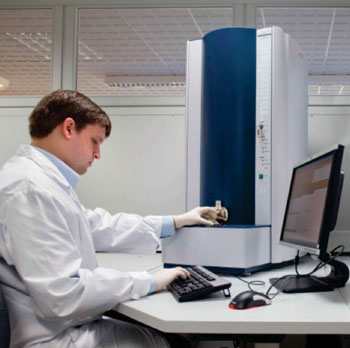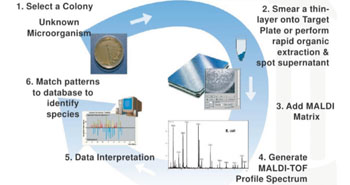Aerobic Bacteria Rapidly Identified by MALDI-TOF Mass Spectrometry
|
By LabMedica International staff writers Posted on 27 Jan 2016 |

Image: The Microflex LT bench-top MALDI-TOF mass spectrometer and BioTyper (Photo courtesy of Bruker Daltonics).

Image: Schematics of the Bruker MALDI BioTyper Workflow (Photo courtesy of Professor Melissa B. Miller).
Matrix-assisted laser desorption ionization time-of-flight mass spectrometry (MALDI-TOF MS) is a diagnostic tool for the identification of organisms routinely found in the microbiology laboratory.
MALDI-TOF MS has been proven to be a rapid and cost-effective diagnostic method for routine use in the clinical microbiology laboratory and MALDI-TOF MS technology uses ionizing laser for structural elements of the isolate to generate isolate-derived spectra, which is then compared to a reference database.
Scientists at the Children's Hospital Los Angeles (CA, USA) and their colleague at the Keck School of Medicine (Los Angeles, CA, USA) used isolates previously recovered by routine culture and workup from clinical specimens were cultured to appropriate media, identified directly by MALDI-TOF MS, and compared to results from various biochemical identification methods. A total of 996 aerobic Gram-positive and Gram-negative organism isolates were included in the study.
All MALDI-TOF MS testing was performed in duplicate with the same swab spotted onto two spots on the target plate, one spot representing a “heavy” inoculum and the second spot representing a “light” inoculum. Acquisition and analysis of mass spectra was performed using the Microflex LT mass spectrometer (Bruker Daltonics; Fremont, CA, USA). For media studies, 84 Gram-negative bacteria were cultured on blood agar, chocolate agar, and MacConkey agar; 74 Gram-positive bacteria were cultured on blood agar, chocolate agar, and colistin nalidixic acid (CNA) agar. For temperature and stability studies, four Gram-negative bacteria and four Gram-positive bacteria were cultured onto blood agar. Results of MALDI-TOF MS were compared to routine methods performed in the microbiology laboratory. All discordant identifications were confirmed by additional biochemical or 16S rRNA sequencing.
In MALDI-TOF MS data interpretation, a score of equal to or greater than 2.0 is equivocal to reliable species-level identification, a score of 1.7–1.99 is considered reliable to the genus level and a score of less than 1.7 is considered unreliable for bacteria identification. Using the direct-smear method, 99.5% and 98.0% of aerobic Gram-negative and Gram-positive bacteria, respectively, were identified to the genus level. At a score of equal to or greater than 1.9, 97.6% Gram-negative organisms and 94.6% Gram-positive organisms were correctly identified to the species level by direct-smear method. Only 1.1% of isolates required further reflex to direct-plate extraction. The direct-smear method proved to be robust, as various growth temperatures, media, culture age, and different operators had no notable impact on the bacterial identification rate.
The authors concluded that the direct-smear method was accurate and effective in streamlining the workflow of Gram-positive and Gram-negative bacterial identification in our clinical laboratory. For simplicity, they recommend using the direct-smear method for the majority of specimens commonly found in the clinical laboratory and an optimized spectral score cutoff of equal to or greater than 1.9 for enhanced species-level identification rates. The study was first published on December 14, 2015, in the Journal of Clinical Laboratory Analysis.
Related Links:
Children's Hospital Los Angeles
Keck School of Medicine
Bruker Daltonics
MALDI-TOF MS has been proven to be a rapid and cost-effective diagnostic method for routine use in the clinical microbiology laboratory and MALDI-TOF MS technology uses ionizing laser for structural elements of the isolate to generate isolate-derived spectra, which is then compared to a reference database.
Scientists at the Children's Hospital Los Angeles (CA, USA) and their colleague at the Keck School of Medicine (Los Angeles, CA, USA) used isolates previously recovered by routine culture and workup from clinical specimens were cultured to appropriate media, identified directly by MALDI-TOF MS, and compared to results from various biochemical identification methods. A total of 996 aerobic Gram-positive and Gram-negative organism isolates were included in the study.
All MALDI-TOF MS testing was performed in duplicate with the same swab spotted onto two spots on the target plate, one spot representing a “heavy” inoculum and the second spot representing a “light” inoculum. Acquisition and analysis of mass spectra was performed using the Microflex LT mass spectrometer (Bruker Daltonics; Fremont, CA, USA). For media studies, 84 Gram-negative bacteria were cultured on blood agar, chocolate agar, and MacConkey agar; 74 Gram-positive bacteria were cultured on blood agar, chocolate agar, and colistin nalidixic acid (CNA) agar. For temperature and stability studies, four Gram-negative bacteria and four Gram-positive bacteria were cultured onto blood agar. Results of MALDI-TOF MS were compared to routine methods performed in the microbiology laboratory. All discordant identifications were confirmed by additional biochemical or 16S rRNA sequencing.
In MALDI-TOF MS data interpretation, a score of equal to or greater than 2.0 is equivocal to reliable species-level identification, a score of 1.7–1.99 is considered reliable to the genus level and a score of less than 1.7 is considered unreliable for bacteria identification. Using the direct-smear method, 99.5% and 98.0% of aerobic Gram-negative and Gram-positive bacteria, respectively, were identified to the genus level. At a score of equal to or greater than 1.9, 97.6% Gram-negative organisms and 94.6% Gram-positive organisms were correctly identified to the species level by direct-smear method. Only 1.1% of isolates required further reflex to direct-plate extraction. The direct-smear method proved to be robust, as various growth temperatures, media, culture age, and different operators had no notable impact on the bacterial identification rate.
The authors concluded that the direct-smear method was accurate and effective in streamlining the workflow of Gram-positive and Gram-negative bacterial identification in our clinical laboratory. For simplicity, they recommend using the direct-smear method for the majority of specimens commonly found in the clinical laboratory and an optimized spectral score cutoff of equal to or greater than 1.9 for enhanced species-level identification rates. The study was first published on December 14, 2015, in the Journal of Clinical Laboratory Analysis.
Related Links:
Children's Hospital Los Angeles
Keck School of Medicine
Bruker Daltonics
Latest Microbiology News
- Handheld Device Delivers Low-Cost TB Results in Less Than One Hour
- New AI-Based Method Improves Diagnosis of Drug-Resistant Infections
- Breakthrough Diagnostic Technology Identifies Bacterial Infections with Almost 100% Accuracy within Three Hours
- Innovative ID/AST System to Help Diagnose Infectious Diseases and Combat AMR
- Gastrointestinal Panel Delivers Rapid Detection of Five Common Bacterial Pathogens for Outpatient Use
- Rapid PCR Testing in ICU Improves Antibiotic Stewardship
- Unique Genetic Signature Predicts Drug Resistance in Bacteria
- Unique Barcoding System Tracks Pneumonia-Causing Bacteria as They Infect Blood Stream
- Rapid Sepsis Diagnostic Test Demonstrates Improved Patient Care and Cost Savings in Hospital Application
- Rapid Diagnostic System to Detect Neonatal Sepsis Within Hours
- Novel Test to Diagnose Bacterial Pneumonia Directly from Whole Blood
- Interferon-γ Release Assay Effective in Patients with COPD Complicated with Pulmonary Tuberculosis
- New Point of Care Tests to Help Reduce Overuse of Antibiotics
- 30-Minute Sepsis Test Differentiates Bacterial Infections, Viral Infections, and Noninfectious Disease
- CRISPR-TB Blood Test to Enable Early Disease Diagnosis and Public Screening
- Syndromic Panel Provides Fast Answers for Outpatient Diagnosis of Gastrointestinal Conditions
Channels
Clinical Chemistry
view channel
Low-Cost Portable Screening Test to Transform Kidney Disease Detection
Millions of individuals suffer from kidney disease, which often remains undiagnosed until it has reached a critical stage. This silent epidemic not only diminishes the quality of life for those affected... Read more
New Method Uses Pulsed Infrared Light to Find Cancer's 'Fingerprints' In Blood Plasma
Cancer diagnoses have traditionally relied on invasive or time-consuming procedures like tissue biopsies. Now, new research published in ACS Central Science introduces a method that utilizes pulsed infrared... Read moreMolecular Diagnostics
view channel
Novel Autoantibody Against DAGLA Discovered in Cerebellitis
Autoimmune cerebellar ataxias are strongly disabling disorders characterized by an impaired ability to coordinate muscle movement. Cerebellar autoantibodies serve as useful biomarkers to support rapid... Read more
Gene-Based Blood Test Accurately Predicts Tumor Recurrence of Advanced Skin Cancer
Melanoma, an aggressive form of skin cancer, becomes extremely difficult to treat once it spreads to other parts of the body. For patients with metastatic melanoma tumors that cannot be surgically removed... Read moreHematology
view channel
New Scoring System Predicts Risk of Developing Cancer from Common Blood Disorder
Clonal cytopenia of undetermined significance (CCUS) is a blood disorder commonly found in older adults, characterized by mutations in blood cells and a low blood count, but without any obvious cause or... Read more
Non-Invasive Prenatal Test for Fetal RhD Status Demonstrates 100% Accuracy
In the United States, approximately 15% of pregnant individuals are RhD-negative. However, in about 40% of these cases, the fetus is also RhD-negative, making the administration of RhoGAM unnecessary.... Read moreImmunology
view channel
Stem Cell Test Predicts Treatment Outcome for Patients with Platinum-Resistant Ovarian Cancer
Epithelial ovarian cancer frequently responds to chemotherapy initially, but eventually, the tumor develops resistance to the therapy, leading to regrowth. This resistance is partially due to the activation... Read more
Machine Learning-Enabled Blood Test Predicts Immunotherapy Response in Lymphoma Patients
Chimeric antigen receptor (CAR) T-cell therapy has emerged as one of the most promising recent developments in the treatment of blood cancers. However, over half of non-Hodgkin lymphoma (NHL) patients... Read morePathology
view channel
Novel UV and Machine Learning-Aided Method Detects Microbial Contamination in Cell Cultures
Cell therapy holds great potential in treating diseases such as cancers, inflammatory conditions, and chronic degenerative disorders by manipulating or replacing cells to restore function or combat disease.... Read more
New Error-Corrected Method to Help Detect Cancer from Blood Samples Alone
"Liquid biopsy" technology, which relies on blood tests for early cancer detection and monitoring cancer burden in patients, has the potential to transform cancer care. However, detecting the mutational... Read more
"Metal Detector" Algorithm Hunts Down Vulnerable Tumors
Scientists have developed an algorithm capable of functioning as a "metal detector" to identify vulnerable tumors, marking a significant advancement in personalized cancer treatment. This breakthrough... Read more
Novel Technique Uses ‘Sugar’ Signatures to Identify and Classify Pancreatic Cancer Cell Subtypes
Pancreatic cancer is often asymptomatic in its early stages, making it difficult to detect until it has progressed. Consequently, only 15% of pancreatic cancers are diagnosed early enough to allow for... Read moreTechnology
view channel
Pain-On-A-Chip Microfluidic Device Determines Types of Chronic Pain from Blood Samples
Chronic pain is a widespread condition that remains difficult to manage, and existing clinical methods for its treatment rely largely on self-reporting, which can be subjective and especially problematic... Read more
Innovative, Label-Free Ratiometric Fluorosensor Enables More Sensitive Viral RNA Detection
Viruses present a major global health risk, as demonstrated by recent pandemics, making early detection and identification essential for preventing new outbreaks. While traditional detection methods are... Read moreIndustry
view channel
Cepheid and Oxford Nanopore Technologies Partner on Advancing Automated Sequencing-Based Solutions
Cepheid (Sunnyvale, CA, USA), a leading molecular diagnostics company, and Oxford Nanopore Technologies (Oxford, UK), the company behind a new generation of sequencing-based molecular analysis technologies,... Read more
Grifols and Tecan’s IBL Collaborate on Advanced Biomarker Panels
Grifols (Barcelona, Spain), one of the world’s leading producers of plasma-derived medicines and innovative diagnostic solutions, is expanding its offer in clinical diagnostics through a strategic partnership... Read more






















